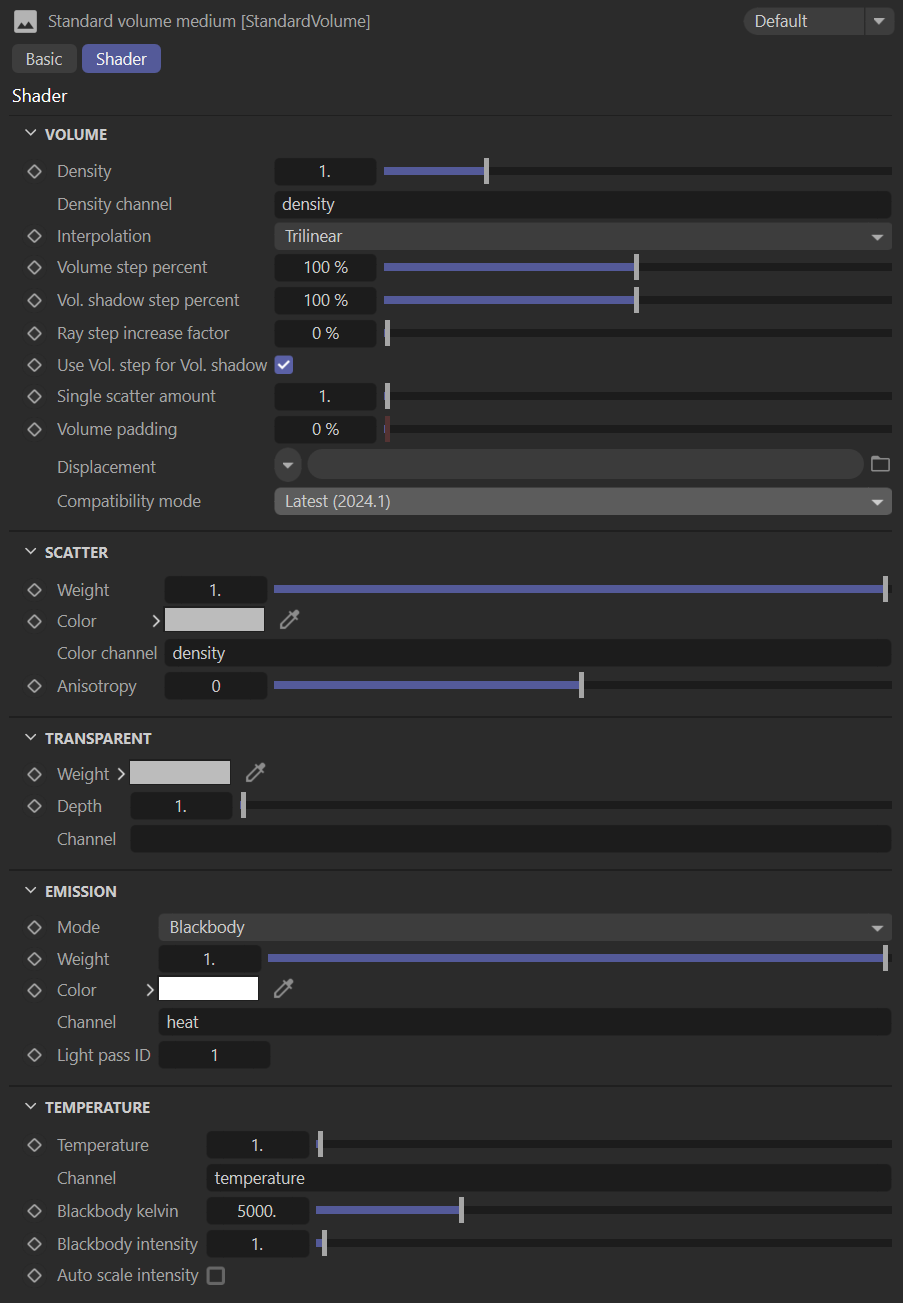Standard Volume Medium
The Standard Volume Medium node is a volume medium node with comprehensive controls for adjusting volume, scatter, transparency, emission, and temperature parameters based on imported VBD grid, Cinema 4D Pyro data or mesh objects with the Octane Object tag set to Particle Rendering > Mesh to Volume.
|
|
Standard Volume — VDB render
|
Standard Volume VDB of the Portal 50 object from The Pixel Lab
|
|
standard volume — mesh to volume render
|
Standard Volume Mesh to Volume
|
|
standard volume medium
|
Standard Volume Medium Parameters
Volume
Density — Specifies the density of the volume which is further scaled by the density channel.
Density Channel — Further specifies density distribution from the imported VBD's grid data.
Interpolation — Determines the interpolation mode used when reading voxel data from the channel inputs.
Volume Step Percent — Only applicable when rendering Volume mediums, is the percentage of the voxel size. This attribute may need to be adjusted depending on the surface. The default value is 100% of the voxel size. Should the volume be smaller than this, the step length will need to be decreased. Please note that decreasing this will reduce the render speed. Increasing this value will cause the ray marching algorithm to take longer steps. Should the step length far exceed the volume’s dimensions, then the ray marching algorithm will take a single step through the whole volume. Most accurate results are obtained when the step length is as small as possible.
Volume Shadow Step Percent — Shadow ray-marching length, specified as a percentage of the voxel size.
Ray Step Increase Factor — How fast the volume ray step will increase.
Use Volume Step for Volume Shadow — Check box to use the Volume Step Length for the Volume Shadow Ray Step Length.
Single Scatter Amount — Determines how often direct light is calculated in the volume.
Volume Padding — Expands the volume bounding box by the given percentage in all 6 directions, but only if sample position displacement is being used.
Displacement — Allows for a texture to control the volume's sample position displacement.
Compatibility Mode — Choose the desired method based upon release version.
Scatter
Scatter Weight — Specifies the amount of scatter applied to the volume.
Scatter Color — Determines the color of the scatter characteristics.
Scatter Color Channel — Provides scatter colors across the voxels of the volume, which act as a multiplier to the scatter color input.
Scatter Anisotropy — Determines the light scattering direction where negative values produce backward scattering and positive values result in forward scattering.
Transparent
Transparent Weight — Additional control over the density of the volume, to tint the color of objects seen through the volume.
Transparent Depth — Provides additional control over the transparency density of the volume.
Transparent Channel — Specifies the channel that provides transparency values across the voxels of the volume, which act as a multiplier to the transparency color input..
Emission
Emission Mode — Determines the mode to calculate emission. The Black Body option additionally uses the Temperature parameters to control emission, otherwise the Temperature parameters have no effect.
Emission Weight — Scales the emission applied to the volume.
Emission Color — This color's value data is a multiplier on the emission weight, the color itself will tint the emission.
Emission Channel — From the imported VBD's grid date, further specifies the channel that provides emission values across the voxels of the volume, which act as a multiplier to the emission color input.
Light Pass ID — The Light Pass ID captures the respective emitter's contribution.
Temperature
Temperature — If a temperature channel is connected, then this scales the values read from it. Otherwise, it is the source of the temperature values, which are usually in the range [0..1].
Temperature Channel — A channel that provides temperature values across the voxels of the volume. These are expected to be in the range [0..1]. Auto scale temperature channel can be enabled to scale them to this range if necessary.
Black Body Kelvin — Scales the temperature values specified in the temperature channel using the Kelvin scale where lower values are cooler and higher values are warmer.
Black Body Intensity — Scales the intensity of the black body emission.
Auto Scale Intensity — Adjusts the temperature values so the maximum value in the channel is mapped to the black body temperature specified in Kelvin. Activating this parameter is common in order to scale back the perceived brightness of the emission.





